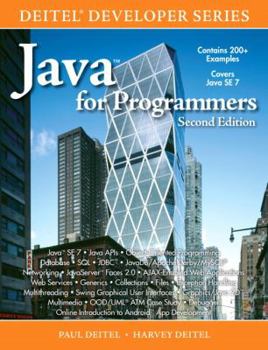Java for Programmers
Select Format
Select Condition 
Book Overview
The professional programmer''s Deitel? guide to Java(tm) development and the powerful Java platform Written for programmers with a background in high-level language programming, this book applies the... This description may be from another edition of this product.
Format:Paperback
Language:English
ISBN:0132821540
ISBN13:9780132821544
Release Date:April 2011
Publisher:Prentice Hall
Length:1126 Pages
Weight:3.35 lbs.
Dimensions:1.4" x 7.1" x 9.1"
Customer Reviews
5 ratings
Best Technical Book
Published by Thriftbooks.com User , 14 years ago
I'd like to say that "Java For Programmers" is THE best technical publication I've worked with (for any software language!). I've been a software developer for over thirty years and have just recently gotten into Java programming. The examples and explanations thereof (love the line by line detail) make everything so much easier to understand.
Misleading Title
Published by Thriftbooks.com User , 14 years ago
A book titled "Java for Programmers" sounds like it would be for "experienced" programmers. A book that wouldn't waste your time with if-then-else statements or for/while statement, but alas this is NOT what this book is about. Instead a better title would have been "Java for SERIOUS Programmers" (as opposed to casual or hobby programmers). This book DOES cover all the basics (groan) but it also covers techniques of serious software development. Here you get an example of object oriented design from the requirements analysis stage to class creation and coding using the current tools such as UML diagrams. While I'm disappointed this book doesn't fast track me through all the old standard stuff, I am pleased to get a refresher and a fresh perspective on the OO design and development part of the process. It's a good book, just be aware of what you're buying.
Reluctant Java Developer
Published by Thriftbooks.com User , 15 years ago
I have been programming for the past 30 years using many procedural languages. I have done a lot of AJAX primarily using Javascript and PHP. I have been avoiding Java for the past few years because I did not want to learn object oriented programming and it seemed so unnecessarily complicated. I have purchased many books on programming in Java, none of these were helpful. Your book is the first that helped me to gradually and logically build my understanding of this very verbose programming framework. I congratulate on this excellent work.
A 'must' reference for any Java programmer
Published by Thriftbooks.com User , 15 years ago
Programmers with a background in high-level language programming will find this 1,100+ page reference packs in details key to Java and the Powerful Java Platform. Concepts are presented in fully tested programs which come with code highlighting and code descriptions of over 220 Java applications with over 18,000 lines of proven Java code. The result is a 'must' reference for any Java programmer and library seeking depth and comprehensive substance in a Java reference.
all the Java
Published by Thriftbooks.com User , 15 years ago
Whew! The Deitels compiled this massive tome on Java 6, which is the current 2008-9 version of java. If you are an aspiring java programmer, it's all here, at least as far as what you are likely to need in understanding the most common aspects and classes of java. However the sheer size of the text is maybe ironically a problem in its own right. Not knowing any java, how much do you need? Part 1 is chapters 1-10. They explain the syntax and describe the basic mathematical operations. There is no GUI. It's all command line I/O. You learn the class structure of java, and the concepts of polymorphism and object oriented programming. En route, UML diagrams are introduced. These are broadly used, not just for java, and useful to acquire. Only simple UML diagrams are explained; not the full graphical expressive power of UML, but it's enough to build on. Part 2 has [only] 2 chapters on graphics. Elementary widgets and accompanying discussion but, hey!, you can now easily write little programs that put up windows with buttons, panes and other stuff. What part 2 also deals with are more advanced non-graphic topics. Like files and exception handling. Part 3 has 1 chapter on more graphics. I personally would have put all 3 graphics chapters into exclusively one section. It's a reality these days that many programs have a GUI, and the book should reflect this need. But aside from merely regrouping the graphics chapters, there could have been a more extensive discussion. Those chapters give example programs which are simple wrappers around using just 1 or 2 types of widgets in each. Which is fine. But what is lacking is at least 1 nontrivial example of a GUI with numerous different widgets, so that the reader can get some appreciation of how to do this. Granted, the book is long enough as is, and it's always easy to say add more. So maybe space considerations dictated the current choices.





